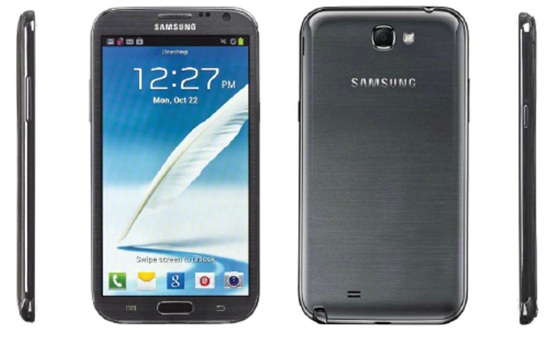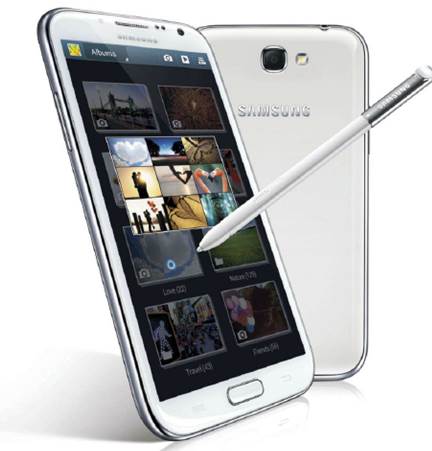The Galaxy Note II for T-Mobile is many
things, but above all, it’s the most phone there is. It gives you more screen,
more processor, and more OS than just about any other phone out there. It’s
also a significant improvement over the first Galaxy Note, thanks to a faster
quad-core processor and Android 4.1 “Jelly Bean” OS, not to mention a host of
Samsung-developed note taking software improvements. If you think other phones
are too small, and prefer something big enough to double as a miniature tablet
that (barely) fits in your pocket, the Galaxy Note II reigns supreme.

A
gorgenous Super AMOLED capacitive touch display and solid 8MP are solid
features on the Galaxy Note II
Design and screen
The Galaxy Note II measures 5.95 by 3.17 by
0.37 inches (HWD) and weighs 6.34 ounces. That’s roughly an inch taller and
half an inch wider than even big smartphones with 4.5 inch and greater screens.
It’s just as thin as those, though, which helps a lot. But unlike some other
Samsung handsets, the Galaxy Note II looks and feels refined, thanks to the
classy, faux-anodized silver finish and a smoked chrome accent ring around the
sides. You can get one in either gray or white.
The star of the show is the stunning
5.5-inch, 1,280 by 720 pixel, Super AMOLED capacitive touch screen. The aspect
ratio is 16:9 this time, instead of 16:10 like the first Galaxy Note, which had
a slightly higher 1,280-by-800-pixel resolution. The display is super bright,
with vivid colors and deep blacks, and viewing angles are uniformly excellent.
You could argue that at 167ppi, pixel depth isn’t as impressive as it is on
smaller phones with the same 720p resolution. But rest assured: This screen
looks fantastic.
As you can imagine, the screen is large
enough for easy typing in both portrait and landscape modes. There’s a hardware
Home button below the screen, flanked by Menu and Back capacitive touch
buttons. You even get an extra row of number keys, so you don’t have to switch
the keyboard mode to enter in digits. A Wacom designed stylus is tucked into a
slot under the bottom right edge. The stylus supports 1,024 levels of pressure
sensitivity four times what the stylus in the Galaxy Note supports and works
well in apps ranging from email to PowerPoint. Shape Match will help perfect
lines and circles you draw, Wolfram Alpha will automatically process any
formulas you write out, and you can also record voice memos while writing.

Given it sizes, the Galaxy Note II is difficult
to use one-handed except that, fortunately, Samsung has already thought of
this. To that end, it provides a series of toggles in Setting > One-handed
Operation. You can move the dial buttons to the left or right, for example, and
position the keyboard and unlock pattern for easier access.
Connectivity and voice calls
The Galaxy Note II is a quad-band EDGE
(850, 1,900, 1,800, 1,900MHz) device with 802.11b/g/n Wi-Fi support on both 2.4
and 5GHz bands. The Galaxy Note II also supports T-Mobile’s excellent Wi-Fi
calling feature, which tap into any connected hotspot for voice calls whenever
there’s not enough cellular signal available.
Voice calls sounded as good as I’ve ever
heard on a cell phone, whether I was using the earpiece or a Jawbone Era Bluetooth
headset. Transmissions through the microphone were clear and punchy, albeit
with a slight amount of noise coming through from the midtown Manhattan street
I tested the phone on. Reception was solid. The rear-mounted mono speakerphone
sounded clear and loud, and should be fine for use outdoors.

Samsung’s S Voice lets you control the Note
by voice. You can wake it up by saying “Hi Galaxy,” double-tapping the Home
button, or by choosing your own phrase. You can also enable or disable
handwriting mode, which activates when you pull the pen from the device. In
addition to voice dialing you can also text, search contacts, navigate,
schedule something on your calendar, add a task, start a music playlist, and
update Twitter, all with your voice.
Hardware, cameras, and conclusions
Under the hood is a 1.6GHz quad-core A9
Samsung Exynos processor and 2GB of RAM. Benchmark results were at top of the
class almost entirely across the board; combine Jelly Bean with a quad-core
processor and you get one fast phone. The results of some gaming frame rate
tests lagged next to those of the Qualcomm powered LG Optimus G, the only other
quad-core phone available in the U.S. right now. But three separate Optimus Gs
overheated repeatedly in our tests, and automatically dialed back screen
brightness to cool down, whereas the Galaxy Note II always stayed cool to the
touch. A 3.5mm headphone jack sits on the top edge of the phone. There’s 16GB
of internal storage, plus a microSD card slot underneath the battery cover that
accepts up to 64GB cards. Music tracks sounded fine through Plantronics
BackBeat Go Bluetooth earphones. The Galaxy Note II hooked into Play Music
account, displayed the correct album covers, and let me stream tracks.
Standalone videos were terrific in full-screen mode and you can pop the movie
into a picture in picture style window that you can reposition while you do
other tasks.
The 8-megapixel autofocus camera has an LED
flash and geo tagging. There’s also a 1.3-megapixel front-facing camera for
video chats. It’s a solid camera; test photos looked sharp, vibrant, and
detailed outdoors, but a little soft and grainy inside. Recorded videos looked
just as good as photos and played smoothly at both 720p and 1080p. the image
stabilization works well; it doesn’t completely eliminate stutters while
walking, but it does a nice job when standing still, and it doesn’t affect the
frame rate although it does remove the ability to snap photos while recording
video.
The Samsung Galaxy Note II is either lust worthy
or ridiculous, depending on your perspective. The Samsung Galaxy S III and HTC
One S are two smaller but still powerful alternatives. But the Galaxy Note II
is an easy recommendation as the most powerful phone in T-Mobile’s line up even
if it’s also the biggest.
Details
Price:
$369.99
Rating:
9/10
Pros:
Massive high-definition screen. Fast quad-core processor. Smooth UI with
plenty of useful touches. Includes a pressure-sensitive stylus and
well-designed note-taking and drawing software. Runs Android 4.1 “Jelly Bean”
out of the box. Stellar call quality.
Cons: Very
large. A few minor hiccups in gaming performance.
|